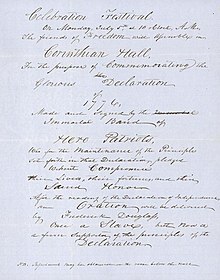
Frederick Douglass was an American social reformer, abolitionist, orator, writer, and statesman. He became the most important leader of the movement for African-American civil rights in the 19th century.

The Underground Railroad was a network of secret routes and safe houses established in the United States during the early to mid-19th century. It was used by enslaved African Americans primarily to escape into free states and from there to Canada. The network, primarily the work of free African Americans, was assisted by abolitionists and others sympathetic to the cause of the escapees. The slaves who risked capture and those who aided them are also collectively referred to as the passengers and conductors of the Railroad, respectively. Various other routes led to Mexico, where slavery had been abolished, and to islands in the Caribbean that were not part of the slave trade. An earlier escape route running south toward Florida, then a Spanish possession, existed from the late 17th century until approximately 1790. However, the network generally known as the Underground Railroad began in the late 18th century. It ran north and grew steadily until the Emancipation Proclamation was signed by President Abraham Lincoln. One estimate suggests that, by 1850, approximately 100,000 slaves had escaped to freedom via the network.

Albert Barnes was an American theologian, clergyman, abolitionist, temperance advocate, and author. Barnes is best known for his extensive Bible commentary and notes on the Old and New Testaments, published in a total of 14 volumes in the 1830s.
David Walker was an American abolitionist, writer, and anti-slavery activist. Though his father was enslaved, his mother was free; therefore, he was free as well. In 1829, while living in Boston, Massachusetts, with the assistance of the African Grand Lodge, he published An Appeal to the Colored Citizens of the World, a call for black unity and a fight against slavery.

The American Anti-Slavery Society was an abolitionist society founded by William Lloyd Garrison and Arthur Tappan. Frederick Douglass, an escaped slave, had become a prominent abolitionist and was a key leader of this society, who often spoke at its meetings. William Wells Brown, also a freedman, also often spoke at meetings. By 1838, the society had 1,350 local chapters with around 250,000 members.

Henry Highland Garnet was an American abolitionist, minister, educator and orator. Having escaped as a child from slavery in Maryland with his family, he grew up in New York City. He was educated at the African Free School and other institutions, and became an advocate of militant abolitionism. He became a minister and based his drive for abolitionism in religion.

Narrative of the Life of Frederick Douglass is an 1845 memoir and treatise on abolition written by African-American orator and former slave Frederick Douglass during his time in Lynn, Massachusetts. It is generally held to be the most famous of a number of narratives written by former slaves during the same period. In factual detail, the text describes the events of his life and is considered to be one of the most influential pieces of literature to fuel the abolitionist movement of the early 19th century in the United States.

The North Star was a nineteenth-century anti-slavery newspaper published from the Talman Building in Rochester, New York, by abolitionist Frederick Douglass. The paper commenced publication on December 3, 1847, and ceased as The North Star in June 1851, when it merged with Gerrit Smith's Liberty Party Paper to form Frederick Douglass' Paper. At the time of the Civil War, it was Douglass' Monthly.

Life and Times of Frederick Douglass is Frederick Douglass's third autobiography, published in 1881, revised in 1892. Because of the emancipation of American slaves during and following the American Civil War, Douglass gave more details about his life as a slave and his escape from slavery in this volume than he could in his two previous autobiographies. It is the only one of Douglass's autobiographies to discuss his life during and after the Civil War, including his encounters with American presidents such as Lincoln and Garfield, his account of the ill-fated "Freedman's Bank", and his service as the United States Marshall of the District of Columbia. Frederick Douglass shed light on what life was like as an enslaved person. Although it is the least studied and analyzed, Life and Times of Frederick Douglass allows readers to view his life as a whole.
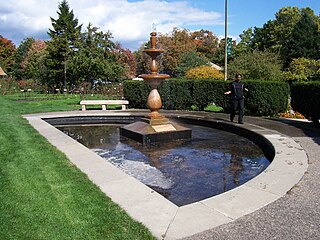
Maplewood Park, also known as Seneca Park West, is a landscaped public park in Rochester, New York, situated between Lake Avenue and the Genesee River. The two-mile-long (3.2 km) park features many trails along the river gorge and the river bank below, scenic views of two waterfalls and a nationally accredited Rose Garden.
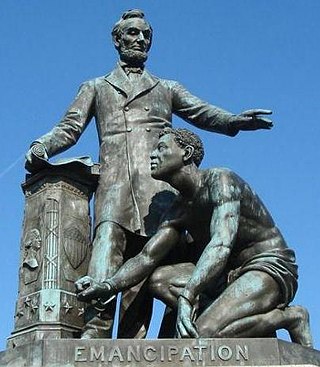
The Emancipation Memorial, also known as the Freedman's Memorial or the Emancipation Group is a monument in Lincoln Park in the Capitol Hill neighborhood of Washington, D.C. It was sometimes referred to as the "Lincoln Memorial" before the more prominent national memorial was dedicated in 1922.
The Liberty Party was an abolitionist political party in the United States prior to the American Civil War. The party experienced its greatest activity during the 1840s, while remnants persisted as late as 1860. It supported James G. Birney in the presidential elections of 1840 and 1844. Others who attained prominence as leaders of the Liberty Party included Gerrit Smith, Salmon P. Chase, Henry Highland Garnet, Henry Bibb, and William Goodell. They attempted to work within the federal system created by the United States Constitution to diminish the political influence of the Slave Power and advance the cause of universal emancipation and an integrated, egalitarian society.

Lindley Moore, was a Canadian-American abolitionist, educator, and farmer. With Frederick Douglass, he coordinated travel plans on the Underground Railroad and they gave speeches at anti-slavery assemblies. Moore worked with Hiram Wilson to identify and make education available for formerly enslaved people who had made it across the United States-Canadian border.
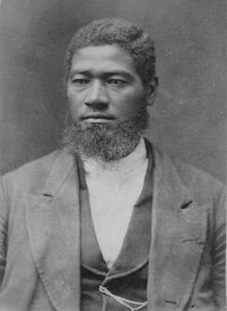
William Gustavus Allen was an African-American academic, intellectual, and lecturer. For a time he co-edited The National Watchman, an abolitionist newspaper. While studying law in Boston he lectured widely on abolition, equality, and integration. He was then appointed a professor of rhetoric and Greek at New-York Central College, the second African-American college professor in the United States. He saw himself as an academic and intellectual.

The Fugitive Slave Convention was held in Cazenovia, New York, on August 21 and 22, 1850. It was a fugitive slave meeting, the biggest ever held in the United States. Madison County, New York, was the abolition headquarters of the country, because of philanthropist and activist Gerrit Smith, who lived in neighboring Peterboro, New York, and called the meeting "in behalf of the New York State Vigilance Committee." Hostile newspaper reports refer to the meeting as "Gerrit Smith's Convention". Nearly fifty fugitives attended—the largest gathering of fugitive slaves in the nation's history.

A statue of Frederick Douglass sculpted by Sidney W. Edwards, sometimes called the Frederick Douglass Monument, was installed in Rochester, New York in 1899 after it was commissioned by the African-American activist John W. Thompson. According to Visualising Slavery: Art Across the African Diaspora, it was the first statue in the United States that memorialized a specific African-American person.
The National Convention of Colored Citizens was held August 15–19, 1843 at the Park Presbyterian Church in Buffalo, New York. Similar to previous colored conventions, the convention of 1843 was an assembly for African American citizens to discuss the organized efforts of the anti-slavery movement. The convention included individuals and delegates from various states and cities. Henry Highland Garnet and Samuel H. Davis delivered key speeches. Delegates deliberated courses of action and voted upon resolutions to further anti-slavery efforts and to help African Americans.

"The Constitution of the United States: is it pro-slavery or anti-slavery?" is a speech that Frederick Douglass gave on March 26, 1860, in Glasgow, in which he rejected arguments made by slaveholders as well as by fellow abolitionists as to the nature and meaning of the United States Constitution. The popularity of the speech led to its being published as a pamphlet.
Corinthian Hall was a meeting hall in Rochester, New York, that was the site of significant speeches and other events. It was built in 1849 and was destroyed by a fire in 1898.
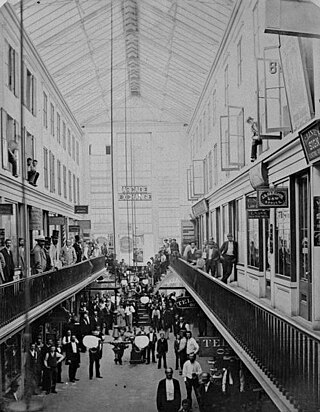
The Reynolds Arcade (1829–1932) was a commercial building constructed by Abelard Reynolds in 1829 on Buffalo Street in Rochester, New York. According to Joseph W. Barnes, a Rochester City Historian, it was, "the center of Rochester downtown life for more than a century." After it was demolished, an office building with the same name was constructed on the same site.



